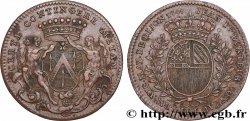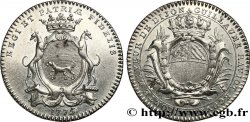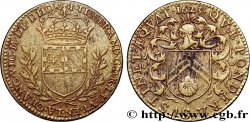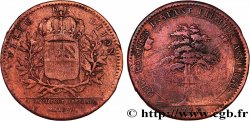fjt_059600 - DIJON (MAIRES DE ... et divers) Pierre Canquoin, prévôt de la Monnaie de Dijon 1593
380.00 €
Quantità
Aggiungi al carrello

Tipo : Pierre Canquoin, prévôt de la Monnaie de Dijon
Data: 1593
Metallo : rame
Diametro : 28,5 mm
Asse di coniazione : 6 h.
Peso : 4,31 g.
Orlo : lisse
Grado di rarità : R3
Commenti sullo stato di conservazione:
Belle patine vert sombre. Flan légèrement voilé et quelques petits coups sur la tranche mais document très intéressant
N° nelle opere di riferimento :
Diritto
Titolatura diritto : +. PIERRE. CANQVOIN. PREVOST. DE. LA..
Descrittivo diritto : Au milieu d’un cartouche fleuronné dans une couronne de laurier : MONNOIE/ DE DIION/ 1593.
Rovescio
Titolatura rovescio : +. LABORARE * ET * LETARI (FLEURS).
Descrittivo rovescio : Écu armorié entre deux tiges de rosier fleuries portant deux étoiles, un coin de droit et de revers ainsi qu’un marteau.
Traduzione rovescio : (Travailler d’abord, se reposer ensuite).
Commento
Pierre Canquoin, prévôt de la Monnaie de Dijon fut chargé de l’analyse des pièces que les Politiques faisaient forger à Saint-Jean-de-Losne. Au revers de son jeton, on remarque en manière d’armoiries, six pièces de monnaie, des coins, un marteau et une fleur qui s’épanouit au centre. Rappelons que la ville de Dijon refusa de reconnaître Henri IV et que la Monnaie de Dijon fabriqua au nom de Charles X jusqu’en 1595, date à laquelle la ville se soumet à Henri IV. Celui-ci, pour concurrencer cette ville ligueuse avait ouvert un atelier à Saint-Jean-de-Losne (puis à Semur) avec les mêmes différents que ceux de l’atelier de Dijon.
Pierre Canquoin, provost of the Dijon Mint, was responsible for analyzing the coins that the Politicians had forged in Saint-Jean-de-Losne. On the reverse of his token, we notice, in the manner of a coat of arms, six coins, dies, a hammer and a flower blooming in the center. Let us recall that the city of Dijon refused to recognize Henry IV and that the Dijon Mint manufactured in the name of Charles X until 1595, when the city submitted to Henry IV. The latter, to compete with this League city, had opened a workshop in Saint-Jean-de-Losne (then in Semur) with the same differences as those of the Dijon workshop.
Pierre Canquoin, provost of the Dijon Mint, was responsible for analyzing the coins that the Politicians had forged in Saint-Jean-de-Losne. On the reverse of his token, we notice, in the manner of a coat of arms, six coins, dies, a hammer and a flower blooming in the center. Let us recall that the city of Dijon refused to recognize Henry IV and that the Dijon Mint manufactured in the name of Charles X until 1595, when the city submitted to Henry IV. The latter, to compete with this League city, had opened a workshop in Saint-Jean-de-Losne (then in Semur) with the same differences as those of the Dijon workshop.








 Segnalare un errore
Segnalare un errore Stampate la pagina
Stampate la pagina Condividi mia selezione
Condividi mia selezione Fai una domanda
Fai una domanda Consegnare / vendere
Consegnare / vendere
 Descrittivo
Descrittivo















